Improving Care for Older Adults
News
Vincent Mor Speaks of Nursing Homes and Big Data at 2019 LDI Leighton Lecture
Brown University Researcher Recounts Discoveries That Have Changed the Field

Brown University professor and health services researcher Vincent Mor, PhD, was guest speaker at the University of Pennsylvania’s annual Charles C. Leighton Memorial Lecture held in the Wharton School’s Colloquium Room in Jon M. Huntsman Hall.
Speaking to a faculty, student, and lay audience at the annual University of Pennsylvania Charles C. Leighton Memorial Lecture, Brown University Professor Vincent Mor, PhD, sought to convey the sense of wonder and discovery he has often felt during his 40 years as a health care big data specialist.
Mor, a Professor of Community Health and health services researcher at Brown’s School of Public Health, has been the principal investigator in nearly four dozen NIH-funded projects focused on the health care services and outcomes for populations of chronically ill elderly patients.

This year’s Leighton Lecture presentation, entitled “Tackling Nursing Home Quality: Big Data as a Catalyst for Policy Research, Pharmaco-Epidemiology and Cluster Randomized Clinical Trials,” was co-sponsored by Penn’s Leonard Davis Institute of Health Economics (LDI), Penn Nursing, the Center for Improving Care Delivery for the Aging (CICADA) and Penn Master of Science in Health Policy Research (MSHP) program.
The dawn of MDS
Mor’s career took a major turn in the early 1990s when he was one of the authors of the Congressionally mandated Minimum Data Set (MDS), a national system for collecting data on the condition of patients in all U.S. nursing homes. He found his real calling in 1998 when, by law, all that MDS data became digital and much more accessible and useful to scientists like himself.
“For MDS,” Mor explained, “nurses and other people do the assessment of the residents, mostly asking about function, walking, cognitive functioning, physical functioning or confusion. This gives you very useful information for deciding what kinds of services and issues older people need addressed. It’s the kind of information clearly necessary for care planning and decision support.”
“In 1999,” he continued, “I began pulling together the mandatory MDS data from nursing homes and Medicare claims; we could link those records to figure out where people were on every given day and we could also link the information to what doctor, what nursing home, what hospital was seeing them and that becomes an aggregate.”
Admission measures
“From that,” Mor said, “we could actually describe the providers in terms of how many people they served. That gave us the measure of how many admissions per bed, which provided a sense of what the ‘turn rate’ was in a given nursing home. A place that has only one admission every three or four months is very different than a place that has five, six, eight admissions every week. The latter looks more like a hospital, the former looks more like a residence. That’s a big difference. And then we can actually create aggregates of that at the population level. So we could say Pittsburgh looks different than Philadelphia looks different than Houston in terms of people’s experiences in long-term care and in post-acute care from place to place.”
“So, now we have nursing home assessments, home care assessments, rehab assessments, and then from Medicare we get the hospital claims, we get the nursing home claims, we get the doctor claims, and also, since 2006 when the Medicare Modernization Act and Part D took effect, we know exactly what drugs most people are receiving. Now all of that can be linked together to a record that the Medicare people have available called an enrollment record, and all of those data can then be put together into an integrated database that has real potential,” Mor said.
‘The limits are your imagination’
“The question is what do you do with all that stuff?,” Mor asked. “I’ve many times told students and fellows and junior faculty, ‘literally the limits are your imagination.’ A young economics PhD student was taking my course last year and she was very interested in environmental health and the water problem catastrophe in Flint, Michigan. So, she worked with a dataset that didn’t have as much detail as I had and she was able to detect an increase in hospitalizations for a particular kidney condition in the hospitals in that area based on whether you were in this county or some other matched counties. And I said ‘Oh, what you really want to do is you want to have the zip code data or the nine digit zip code data where people exactly live because they show which households were exposed and which households weren’t exposed.’ That’s what she’s doing for her dissertation. I would have never in a billion years thought of that exact question but it’s really good, it’s very topical, and it’s great. So that’s the kind of things you can do with these kinds of data.”
“I believe the frontier in the use of this kind of information structure,” Mor said, “is pragmatic cluster randomized clinical trials. That’s when you actually do clinical trials embedded in real healthcare systems with outcomes actually gathered as you’re intervening in a rigorous manner — which is often a complicated thing when you’re working in healthcare.”
